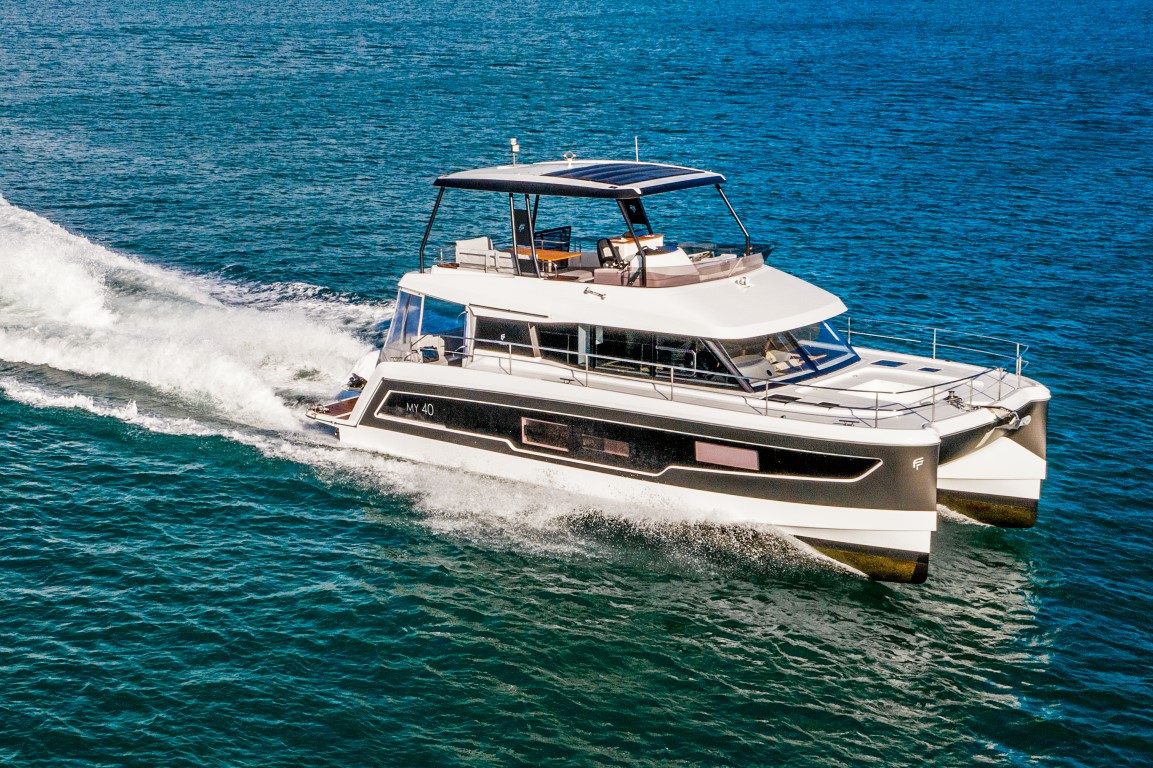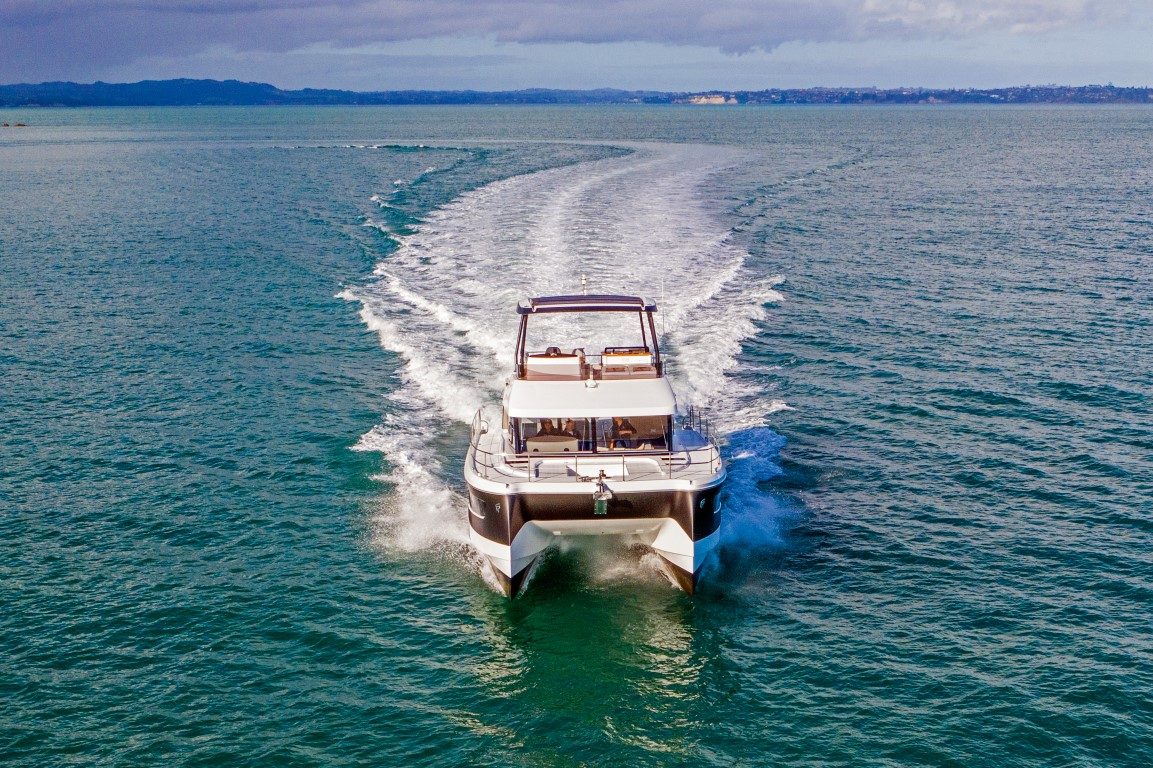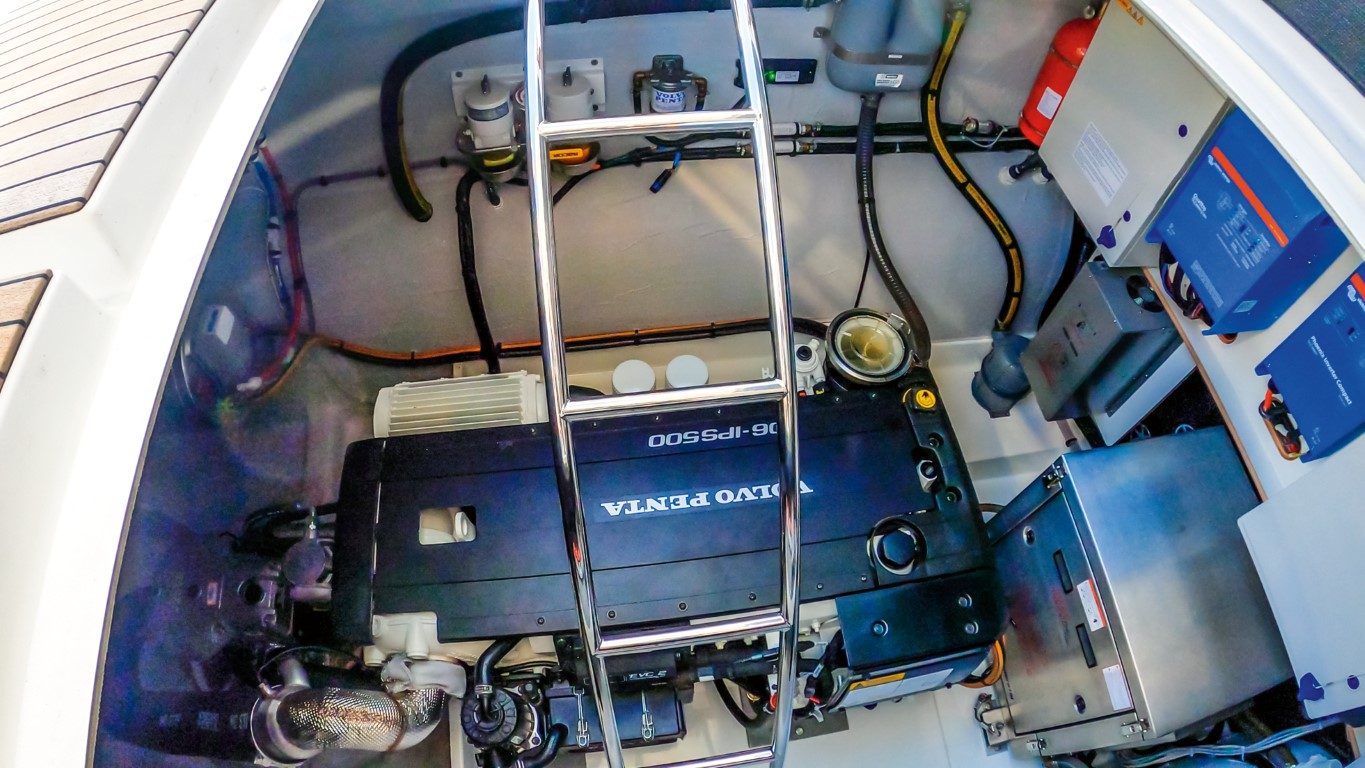‘Behemoth’ is a word which springs to mind or, perhaps more nautically, ‘leviathan’.
- Fast, economical cruising speed
- Comfortable ride
- Stable at rest and when underway
- Easily managed
- Spacious for a 40-footer
- Suits the Kiwi boating lifestyle
The latest addition to Ownaship’s Auckland-based fractional ownership fleet is a French-built Fountaine Pajot MY 40, hull #5 and the first of this new model in the southern hemisphere.
Sporting masses of space, on deck and below, it’s the perfect fit for Ownaship, which was seeking a versatile, spacious, easily-handled vessel that would have wide appeal. The Fountaine Pajot MY 40 certainly fits the bill.
Make no mistake, this is a big 40-footer! That impression is inescapable dockside and reinforced on the water, where there’s acres of entertainment-ready cockpit and a huge saloon, not to mention a flybridge big enough for tennis.

A hydraulic swim platform is good for fishing (bait table included), swimming, launching and transporting the tender. The teak-soled cockpit is laid out for relaxing with a full-width lounger and teak grate-style table that stows away in the generous storage locker under the floor. The cockpit is covered by the upper deck and can be fully enclosed with clears for all-weather use. This vessel also has the optional electric sunshade.

Cockpit hatches and ladders allow easy access into the engine rooms, one in each hull. There’s plenty of room, including for additional equipment. This vessel is furnished with an optional genset and a watermaker, enhancing its suitability for New Zealand-style cruising.
Access to the flybridge is via a spiral staircase on the port side of the cockpit.
Big inside and out
Sliding doors open the cockpit to a spacious galley aft on the starboard side, equipped with Bosch appliances and stone counter tops. All appliances (convection/microwave oven, dish-drawer, fridge), including a two-element cooktop and the grill upstairs, are electric and the fridge on the port side is domestic-sized.
Take a step up from the galley into the spacious carpeted saloon, with access into the port hull aft between the galley and saloon and into the starboard hull just aft of the helm station. The main switchboard is tucked into a locker in the aft companionway, where’s it’s relatively easy to get to when stepping aboard.

The saloon table can be raised and lowered electrically, a factory option included in this vessel, which is loaded with extras. The table features folding leaves and a pair of chairs that can be moved around as required, as well as a comfortable, fabric-covered wrap-around settee on the port side. There’s a drinks cabinet and icemaker to starboard. Large windows, light oak cabinetry and generous headroom accentuate the saloon’s sense of space, a commodity catamarans offer in spades. In that respect, and many others too, you get a lot more boat for your 40 feet of length.

The saloon helm station is smart-looking but relatively simple. On this vessel, there’s a single 15-inch Garmin MFD, a Volvo-Penta digital display panel, Auto-anchor control, engine start-stop switches, communications gear and the Garmin autopilot. This boat is equipped with a pair of uprated 370hp Volvo-Penta IPS 500s with joystick control for close-quarters manoeuvring. The helm seat easily accommodates two, with a bolster for support if standing up to drive. Vision is excellent in all directions and a single wiper keeps the windscreen clear.

And it’s not just the saloon that boasts generous proportions: the foredeck is vast while wide side decks afford easy walk-around access. A pair of loungers either side of a huge under-sole bow locker (the next biggest MY has a cabin in this space, which gives you and idea how much storage is available) and there is no shortage of drink holders for sun-worshippers. The anchor and chain have been up-specced here in New Zealand for Kiwi-style boating.
Accommodation
The port hull contains the master cabin. The companionway sports generous storage lockers while the cabin, lined with white oak, is surprisingly spacious. An island-style queen berth set across the cabin addresses the cabin’s large picture window (there’s also a smaller opening port) and there’s a desk/dressing table and shelving along the port side with locker storage and seating across the back wall. The cabin is longer than it is wide, but avoids feeling corridor-like.

A similarly good-sized ensuite bathroom is situated forward of the master cabin, accessed via a sliding cavity door. The bathroom narrows towards the bows, where the toilet is situated, but the shower, longer than it is wide, is still a good size while the vanity, full-height locker with its tall mirror take up the whole of the bathroom’s starboard side.

The starboard hull, accessed via the forward companionway behind the helm, contains the guest accommodation, comprising two cabins with a shared bathroom (compact, but separate, shower) separating them. The aft cabin has a double berth that enjoys a large picture window with an inset opening porthole, an overhead fan and a good-sized hanging locker.
The forward cabin likewise boasts a double berth. The bed fills pretty much all of the cabin, from wall to wall, the mattress tapering towards the bow, but there is a decent hanging locker a seat, as well as a picture window and a couple of overhead hatches for light and ventilation. The vessel’s washer-dryer is housed in a companionway locker.
Outdoor living
The massive flybridge is where most people will spend their time aboard the MY 40, at least when the weather is fine. The Fountaine Pajot MY range is constructed using resin-infusion techniques for improved strength but low weight. Much of the interior is built in modules at the factory which are then dropped into the boat and bonded to the hull, resulting in a seamless almost organic interior.

The flybridge benefits from this technology not only in reduced top weight, but also from the many features moulded into the upper deck. Features like the timber trimmed outdoor galley with Kenyon electric grill/BBQ and in bench fridge and rubbish bin, moulded wrap-around seating aft, a moulded helm console with a carbon fascia, built in storage galore and lots of versatile and adjustable lounging spaces. The whole upper deck is covered by a fibreglass hardtop with a sliding fabric sunroof. Enclosing it with optional clears keeps the weather out.

The upper deck’s helm station has all of the functionality of the main helm downstairs, including 15-inch Garmin MFD, joystick control and electronic throttle and shift, but only a single bucket-style helm seat. The upstairs entertainment zone also benefits from a Fusion stereo and plenty of LED lighting for night use. Downstairs features a Bose sound system.
Stability plus
Zipping along on a fine, if somewhat chilly, winter’s day, we were pleasantly surprised by how well the acrylic dodger on the upper beck deflects the slipstream over the helmsman’s head. Even without clears, it was comfortable enough up top, but you always have the option of conning the vessel from downstairs when it’s a bit unpleasant outside.
The MY 40 cruises very happily at 20-21 knots, the twin Volvos turning at 3,100rpm. Pushing the throttles to the stops saw us climb to 22 knots/3,400rpm using 122 litres per hour combined, both engines. Knock the speed back to 16-18 knots and the vessel sips fuel at a much slower rate.

This is a very comfortable vessel. Underway, lateral stability is excellent and there is little or no heel in the turns. That catamaran stability is also noticeable at rest, the boat barely rocking.
Enhanced stability compared to monohulls benefits power catamaran owners in many ways, not least the fact that objects on board are less likely to move around when the boat’s underway, so there’s less need to stow things away. It’s certainly easier to prepare and serve food on the go and these benefits carry over to when the boat is anchored: boat wakes won’t set the boat to rocking.

The ride is good too, with no discernible thumping through the bridge deck. On the vessel’s delivery from the Port of Tauranga to Auckland, it cruised the whole way at 17 knots through 20-25 knots of nor’east wind and a lumpy sea.
Cats generally don’t like attacking big seas head on, preferring to cross them at a slight angle, and the MY 40 is unlikely to be any different, but it should be a forgiving, easy to manage vessel in most conditions.

One of four
All four shares in this vessel have been sold, and all four shareholders have bought themselves a whole lot of family boating pleasure at a very reasonable price with almost none of the usual hassles of boat ownership. That’s why Ownaship’s fractional ownership model is attractive to so many Kiwi boaters.
Multihull Solutions is the New Zealand agent for Fountaine Pajot.
‘Behemoth’ is a word which springs to mind or, perhaps more nautically, ‘leviathan’.
White Pointer has earned the respect of discerning customers in New Zealand and Australia, attracting a loyal and ever growing following for its high-quality, rugged and totally dependable aluminium trailer boats.
The hardtop SP635 shares the same underpinnings as the popular SF 635 which was a completely new model back in 2020.
The pride and joy of a multi-generational family, Bliss resides on a pier that’s home to a couple of other Elite motor launches – Sandspit Marina is a hot-spot for the Bill Upfold-designed vessels, with several calling this small marina home.